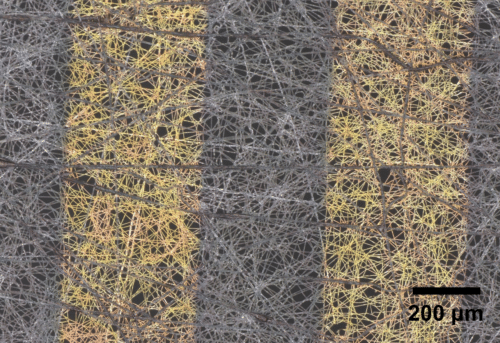A study published in Advanced Science described a newly designed ultrathin mesh-type polymer PTC thermistor that could easily stretch and bend which enhances the flexibility of wearable medical sensors

Wearable healthcare devices have to be flexible enough so that they can be stretched and bent down to several hundred micrometers and hence can move with the human body. The most important feature is it needs to be gas-permeable to avoid irritation and discomfort. Hence, researchers showed how can we fabricate the most essential component of sensors called a thermistor using ultrathin fiber-mesh.
“An overheat protection circuit is required to avoid burning biological tissues during the operation of flexible devices. One candidate is a polymer positive temperature coefficient (PTC) thermistor, which has a large increase in resistance within a narrow temperature range,” said Chihiro Okutani, an assistant professor in the Department of Electrical and Computer Engineering at Shinshu University in Japan. “For such thermistors to be applied for on-skin medical sensors, they must be stretchable and bendable down to several hundred micrometers. However, it is still challenging to fabricate a thermistor whose temperature characteristics do not deteriorate when wrapped around a needle with a bending radius of less than 1 mm.”
The thermistor must be ultrathin to make it flexible enough to wrap around the needle. Hence, researchers implemented a technique called electrospinning to fabricate the ultrathin mesh-type polymer PTC thermistor. Electrospinning uses electricity to create tiny fibers. The fibers can be made using different materials, but in this case, researchers utilized a solution of composite materials. After experimenting with this mesh-type polymer PTC thermistor it exhibited an increase in resistance of three orders of magnitude which is an essential characteristic for preventing overheating and burns. By using a mesh structure, the thermistor also achieved transparency, which can help the sensors blend into the skin, and gas-permeability. Gas-permeability is important to prevent irritation and discomfort. “We also demonstrated the operation of the thermistor wrapped around a 280-micrometer needle by fabricating the fibers on a 1.4-micrometer ultrathin film,” said Okutani.
“Our next step is practical applications of the developed thermistors. We believe that the ultra-flexible and gas-permeable thermistors can act as overheat prevention components for on-skin or implantable devices, which make flexible sensors safer to operate and more reliable,” said Okutani.
Click here for the Published Research Paper








